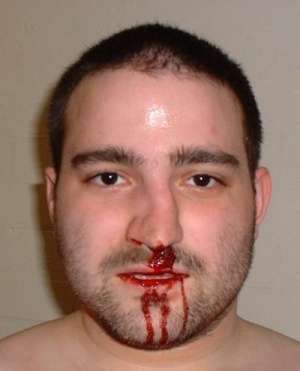Nasal fracture
Background
- Always assess for associated head, face, and neck injuries
Clinical Features

Displaced nasal fracture with epistaxis.
- Nasal deformity, bony crepitus
- Profuse epistaxis
- Periorbital ecchymosis in the absence of other findings of orbital injury
Pediatric Considerations
- More cartilage present
- Septal hematomas are more common, as nasal septum is more at risk of injury
- Injuries heal more quickly, requiring followup in 7-10 days, whereas adults should seek specialist care in 2 weeks.
Differential Diagnosis
Evaluation
- Clinical diagnosis (imaging rarely needed)
Management
Most nasal fractures do not require immediate intervention
- Exclude other associated traumatic injuries
- Treat septal hematoma if present
- Immediately incise and drain
- Consider ED reduction (only if patient presents before significant swelling has occurred)
- Anesthesia
- Place lidocaine soaked cotton pledgets for 5 minutes
- Inject local anesthetics
- Perform infraorbital and supraorbital nerve block if needed
- Reduction
- Insert elevator until contact is made with the depressed nasal bone
- Lift depressed nasal bone anteriorly and laterally in one fluid motion
- Use external splinting and/or nasal packing to maintain alignment
- Anesthesia
Disposition
- Outpatient
- Refer to ENT within 6-10 days regardless of whether perform reduction or not
- No nose blowing
See Also
References
This article is issued from
Wikem.
The text is licensed under Creative
Commons - Attribution - Sharealike.
Additional terms may apply for the media files.